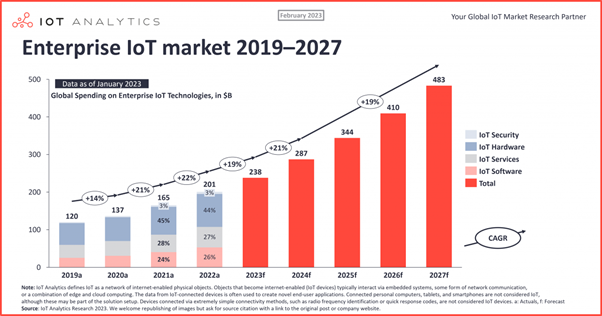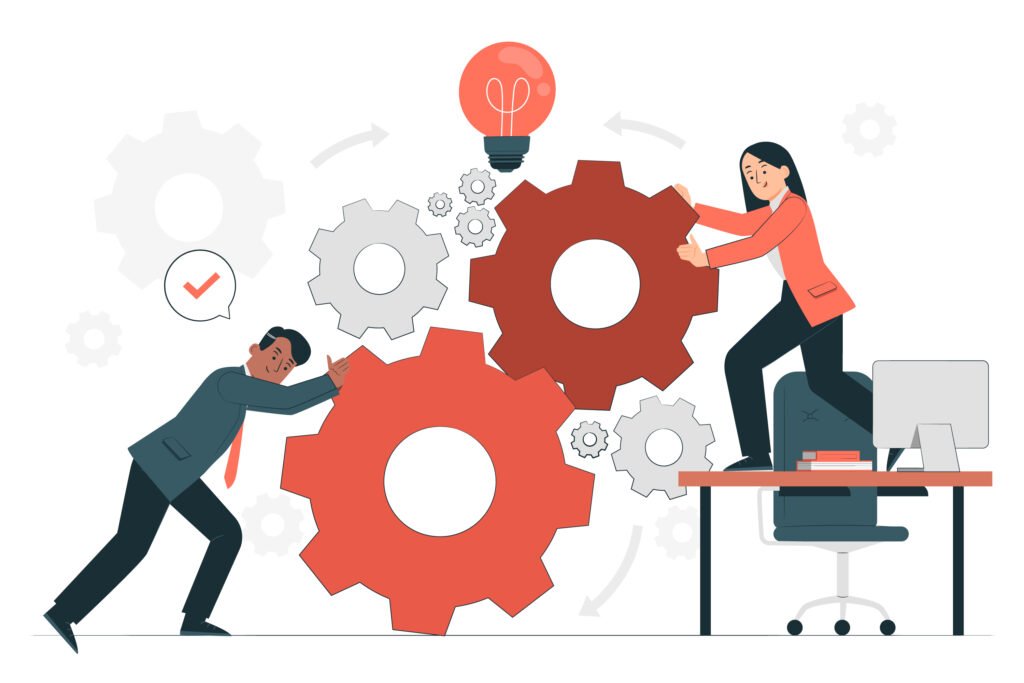IoT architecture explained: key components, their role, and overall challenges
23 Jan 2024
Igor Kelly

What distinguishes an automated device, such as a motion-controlled light switch, from an IoT-connected device that performs the same task? Simply put, it is data. In an IoT-connected device, when a sensor detects motion and an actuator turns on a light, these actions are captured as data and sent to the cloud or a data center for recording and analysis.
Where there is data, there must also be an IoT architecture that tells the data where to go, what format to use, how to get there, and what actions to take based on that data. The effectiveness and applicability of such a system correlate directly with the quality of its basic building blocks and the nature of their interaction.
This article explains how the Internet of Things works, its importance, architecture components, and security considerations.
IoT Architecture Basics
With approximately 15.14 billion IoT devices in 2023, businesses worldwide are increasingly applying IoT technology to enhance efficiency and manage operations at scale. Remote asset monitoring emerges as the leading use case, reflecting the growing influence of IoT in shaping modern workplaces and cities.

The IoT market for enterprises will grow by 21% by 2024 (source: IoT Analytics)
Let’s look at the IoT architecture layer by layer and consider the practical application of each stage.
- Perception layer: The perception layer, or device layer, includes sensors, cameras, and actuators, gathering data for various tasks. In smart agriculture, soil moisture sensors provide real-time data to optimize irrigation.
- Transport layer: The transport layer transmits data from on-site sensors to a data center. IoT gateways convert analog to digital, utilizing data transfer protocols. This layer, for example, enables real-time monitoring and adaptive traffic control in a smart city traffic system.
- Edge layer: Addressing latency challenges, the edge layer processes data closer to the source. Smart edge devices in industrial IoT detect anomalies and trigger rapid responses. Interoperability is crucial for seamless integration with devices from different manufacturers.
- Processing layer: The processing layer, or middleware, uses cloud computing for superior performance. It analyzes data in three stages: accumulation, abstraction, and analysis. For instance, it categorizes unstructured data like audio and video streams into data lakes, ensuring efficient storage.
- Application layer: Decoding patterns, the application layer creates human-readable summaries, like graphs. It includes programs for device control, monitoring, and process control software. This layer, for instance, compiles patient data into easily interpretable formats in a healthcare IoT application.
- Business layer: The business layer distills insights from decoded patterns, projects future trends, and drives operational decisions. It improves efficiency, safety, cost-effectiveness, and customer experience. In retail IoT, analyzing customer behavior at this layer aids inventory management and personalized marketing.
- Security layer: The security layer is crucial for IoT, covering equipment security, cloud security, and connection security. In a smart home IoT system, this layer protects devices from malware, secures data processing in the cloud, and ensures encrypted data transmission across networks using protocols like TLS.
The multi-level structure of the IoT allows for operating your smart devices, leveraging artificial intelligence and machine learning to improve data collection and automate processes.
Roles of Components in the IoT Ecosystem
Integrating the Internet of Things has revolutionized business operations, offering capabilities such as remote problem identification, predictive maintenance insights, and quality assurance in production lines. Notably, these applications have a direct impact on a company’s revenue. Below, we’ll delve into the specific roles of essential components within the IoT ecosystem that contribute to modern businesses’ enhanced efficiency and profitability.
Devices and sensors
Devices and sensors in IoT architecture encompass a diverse range of physical objects equipped with embedded technology to collect and transmit data. For instance, smart thermostats or wearable fitness trackers serve as devices, while sensors could include temperature sensors, motion detectors, or heart rate monitors.
- Generating data: Devices and sensors play a crucial role in continuously collecting information from their surroundings. For example, a temperature sensor in a smart home constantly measures room temperature, contributing real-time data to the IoT system. This data is the foundation for the architecture’s analytics, decision-making, and automation.
- Interacting with the physical world: This component is responsible for interacting with the physical world by capturing and interpreting real-world events. An example is a motion sensor in a security system that detects movement and triggers an alarm. Devices and sensors act as the bridge between the digital and physical realms, enabling the IoT system to respond and adapt based on the input received from the environment.
Connectivity
Connectivity in the IoT architecture facilitates communication between devices, ensuring seamless data exchange within the ecosystem. This involves enabling protocols and standards for device communication, such as MQTT or CoAP, allowing devices to share information efficiently. Additionally, it establishes networks, both wired and wireless, to support the continuous and reliable transfer of data between connected devices, enhancing the overall connectivity infrastructure of the IoT system.
Check the connectivity’s two main functions below and how they contribute to the IoT ecosystem:
1. Enabling communication between devices:
- Device identification and authentication. Devices receive unique identifiers, like MAC addresses, during manufacturing. Authentication protocols, including secure keys and certificates, ensure only authorized devices connect, enhancing network security.
- Network discovery and configuration. Devices scan for nearby networks, configuring connection settings like IP addresses and protocols. This tailored configuration seamlessly integrates devices into the chosen network.
- Protocol establishment. Devices agree on a common communication protocol (e.g., MQTT or CoAP), ensuring standardized data exchange for seamless interaction.
- Data format standardization. Standard data formats (e.g., JSON or XML) are defined, promoting consistent data representation across devices with varied functionalities.
- Secure communication setup. Encryption mechanisms (e.g., TLS/SSL) fortify the communication channel, safeguarding data from unauthorized access during transmission. This security commitment is vital for data integrity and confidentiality.
2. Establishing a network for seamless data transfer:
- Infrastructure selection. To ensure stable IoT ecosystem utilization, a thorough assessment is conducted to choose the most suitable network infrastructure. Data volume, range, and power consumption guide the selection process, ensuring alignment with the system’s specific needs.
- Network topology design. This step involves the creation of a detailed network architecture, intricately defining the arrangement and interconnection of devices.
- Network configuration. This feature focuses on fine-tuning network settings, encompassing IP address assignment, routing protocol definition, and bandwidth management. The goal is to achieve seamless compatibility and integration with the existing network infrastructure.
- Quality of Service (QoS) implementation. Critical to applications relying on real-time data transfer, this step involves applying Quality of Service (QoS) parameters practically. Prioritizing high-priority data traffic ensures the timely delivery of essential information, addressing the demands of applications dependent on instantaneous data transmission.
- Redundancy and failover mechanisms. Automatic switching to alternate paths during component failures minimizes downtime, underscoring the importance of resilient network infrastructure in maintaining uninterrupted operations. A built-in failover mechanism ensures uninterrupted device connectivity by automatically switching communication to a secondary server if the primary server experiences a disruption.
Edge computing
IoT systems collect analog data, and data acquisition systems convert this into digital data. Therefore, the post-process size of digital data is enormous. And analysts agree: data volume will explode in the next decade. By 2025, the amount of new data is expected to exceed 163 zettabytes, an equivalent of 16 billion of today’s 12 TB HDDs.
Here comes an edge computing IT system. IoT devices require a large part of their sensor data to function, but after that, this becomes obsolete. Edge computing pre-sorts this data without major delays and close to the point of origin. After the initial analysis, it deletes real-time relevant data and only forwards its insights to the server or cloud. You can also benefit from them later. This indispensable IoT component also comes with the following benefits:
- Decentralized processing. Edge computing in IoT involves executing computational tasks directly on edge devices, such as sensors or gateways, rather than relying solely on centralized cloud resources.
- Reduced bandwidth usage. By processing data locally, raw information is analyzed and filtered on-site, minimizing the volume of data transmitted to the cloud. This results in reduced latency and optimized bandwidth usage.
- Real-time decision-making. Localized processing enables real-time decision-making, allowing swift responses to critical events without round-trip communication to a distant cloud server, enhancing overall system efficiency.
The IoT infrastructure allows businesses to gather and analyze customer behavior data through devices and sensors. Connectivity ensures a smooth flow of information, while edge computing processes data at the source. This collaborative approach enables personalized services, quicker response times, and improved product offerings, ultimately translating into increased profits.
Major Challenges of IoT Infrastructure

The IoT surge introduces significant challenges to its infrastructure. Essential prerequisites include tackling data throughput issues caused by the overwhelming volume of device-generated data, resolving compatibility concerns due to diverse protocols, ensuring scalability as IoT systems expand, and prioritizing interoperability for seamless communication among devices. Security and privacy concerns also demand attention when IoT software development to safeguard sensitive data in this interconnected landscape.
Below, we discuss each of these challenges in detail.
1. Bandwidth and data throughput
Broadband networks that can provide large bandwidths on demand are best suited for video surveillance, conferencing, video, and photo storage. But what if a company has dozens of small branches scattered throughout both rural and urban areas? As the number of remote workers increases, companies may have home workers in rural areas who need to use what is available, such as DSL.
If the company wants to collect large amounts of data on-site, the data may need to be captured and then downloaded to a local server in a remote office. In these use cases, IT needs to consider where implementing a more expensive broadband connection is feasible and cost-effective and where other connectivity solutions are more suitable.
Lightpoint team suggests the following three mitigation tips to enhance IoT architecture in such cases:
- Optimize data processing locally: To alleviate bandwidth strain, consider implementing local data processing at remote branches. Process and filter data locally before transmitting only essential information to the central server. This reduces the amount of data that needs to traverse the network, enhancing efficiency.
- Prioritize connectivity solutions: Evaluate the connectivity needs for each remote location individually. Instead of a one-size-fits-all approach, prioritize suitable connectivity solutions. For areas with limited broadband access, explore alternatives such as satellite, low-power wide-area networks (LPWAN), or 5G, based on cost-effectiveness and feasibility.
- Implement edge computing: Leverage edge computing to perform data processing closer to the data source. This reduces the need for extensive data transmission by handling analysis and decision-making at the edge. Edge computing minimizes latency and enhances the overall performance of IoT systems, especially in distributed environments.
2. Compatibility limitations
There are a large number of start-ups in the IoT industry without a uniform standard for interoperability. Some IoT solution providers have their own proprietary operating systems that do not interface with other systems.
The result can be an assortment of independent IoT silos. The organization will inevitably need to connect all these devices for data exchange, and there may not be an easy way to do this. IT administrators must test device compatibility and work with vendors who have taken steps to integrate their products or services.
Given the Lightpoint team’s experience as a full cycle software development company, these two mitigation tips to enhance compatibility in IoT architecture:
- Adopt standardized protocols: Encourage the use of standardized communication protocols across IoT devices. Promote industry-wide adoption of protocols such as MQTT or CoAP to ensure interoperability. Standardization facilitates smoother integration between devices, reducing the risk of creating isolated IoT silos.
- Collaborate on open standards: Foster collaboration among IoT solution providers to establish open standards. Encourage the development of open-source solutions and interoperable frameworks that can be universally adopted. This approach promotes a more cohesive IoT ecosystem, where devices from various manufacturers can seamlessly communicate and share data.
3. Scalability hurdles
Companies expanding their IoT deployments need to figure out how to scale their infrastructure sustainably. As infrastructure expands, organizations need to add more IoT devices such as sensors, routers, gateways, or cameras and implement platforms or services that can monitor all activities, control security, and automatically perform software and firmware updates and deployments.
To achieve this, IT departments are challenged to both automate and transform networks and systems so that both can scale with the growth of IoT. IT teams must also review each IoT device to ensure it is compatible with the underlying networks, systems, and other IoT devices.
4. Cybersecurity threats
Many IoT devices come with preset security settings that do not meet the standards a company should use. IT administrators should inspect devices and set them to corporate standards before installation, following best practices such as changing default passwords and implementing network segmentation. Despite these precautions, more IoT devices and connections also mean more security points and vulnerabilities.
The Lightpoint team compiled three mitigation tips to further secure-proof IoT architecture:
- Comprehensive security audits: Conduct thorough security audits on IoT devices before installation. This includes not only inspecting and adjusting default settings but also assessing the overall security posture. Regular audits should be performed to identify and remediate vulnerabilities, ensuring that devices consistently meet corporate security standards.
- Continuous employee training: Invest in ongoing training for IT administrators and other personnel involved in IoT device management. Educate them on evolving security threats, best practices, and the importance of adhering to corporate security standards. Well-informed staff are better equipped to implement security measures effectively and respond to emerging risks.
- Implement automated security updates: Integrate automated systems for security updates and patches across IoT devices. Regularly update and patch devices to address vulnerabilities promptly. Automation ensures a timely and consistent application of security measures, reducing the window of exposure to potential threats.
By adopting this and the abovementioned mitigation strategies, organizations can enhance their IoT architecture’s interoperability, scalability, and security. Proactive measures, continuous training, and automated security practices collectively contribute to a more resilient defense against evolving challenges in the expanding IoT landscape.
Conclusion
A cross-country Gartner survey shows that 47% of the companies surveyed want to increase their investments in IoT. By 2023, a third of companies that already use IoT have planned to implement AI in connection with at least one IoT project, and 2024 will show us the outcomes. Especially in this combination, the technology opens up the opportunity for companies to develop new business models.


